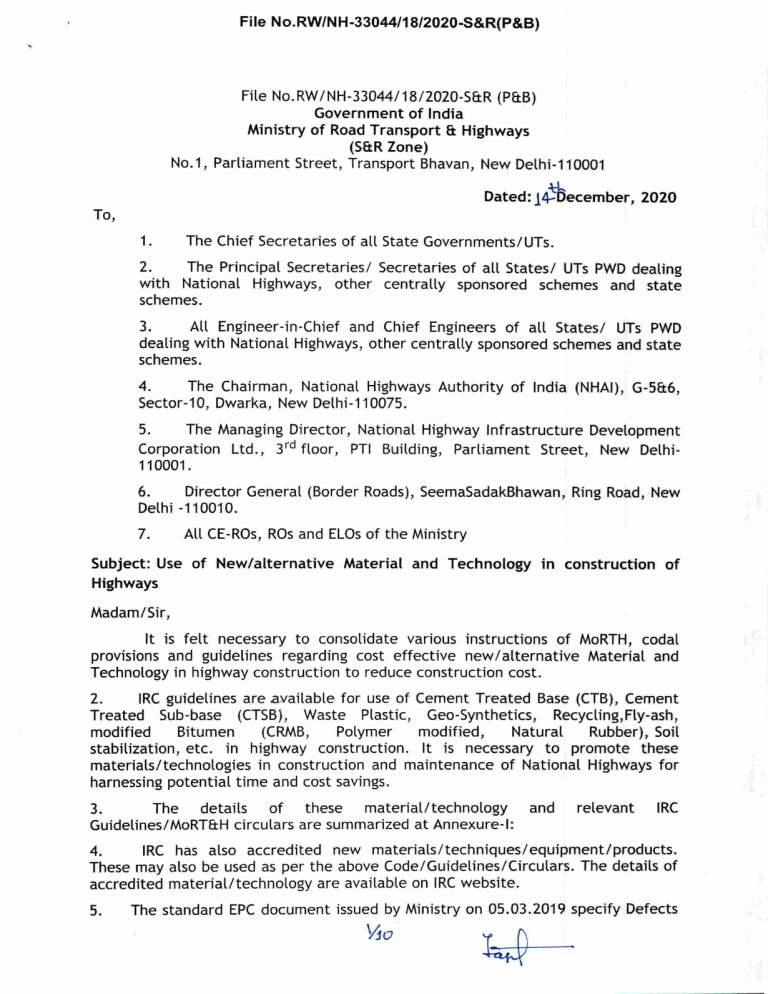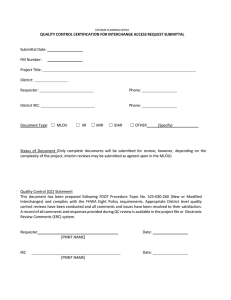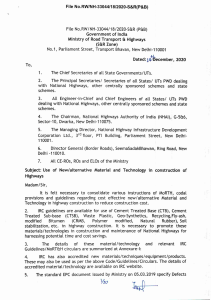
File No.RW/NH-33044/18/2020-5&R(P&B)
File No.RW/NH-33044/18/2020-S&'R(P&'S)
Government of India
Ministry of Road Transport & Highways
(S&RZone)
No.1, Parliament Street, Transport Bhavan, New Delhi-l10001
Dated: l~'ecember,
2020
To,
1.
The Chief Secretaries of all State Governments/UTs.
2.
The Principal Secretaries/ Secretaries of all States/ UTs PWDdealing
with National Highways, other centrally sponsored schemes and state
schemes.
3.
All Engineer-in-Chief and Chief Engineers of all States/ UTs PWD
dealing with National Highways, other centrally sponsored schemesand state
schemes.
4.
The Chairman, National Highways Authority of India (NHAI), G-5&.6,
Sector-10, Dwarka, New Delhi-110075.
5.
The Managing Director, National Highway Infrastructure Development
Corporation Ltd., 3rd floor, PTI Building, Parliament Street, New Delhi110001.
6.
Director General (Border Roads),SeemaSadakBhawan,Ring Road,·New
Delhi -110010.
7.
All CE-ROs,ROsand ELOsof the Ministry
Subject: Use of New/alternative
Highways
Material and Technology in construction
of
Madam/Sir,
It is felt necessary to consolidate various instructions of MoRTH, codal
provisions and guidelines regarding cost effective new/alternative Material and
Technology in highway construction to reduce construction cost.
2.
IRCguidelines are available for use of Cement Treated Base (CTB), Cement
Treated Sub-base (CTSBj, Waste Plastic, Geo-Synthetics, Recycling,Fly-ash,
modified
Bitumen
(CRMB, Polymer
modified,
Natural
Rubber), Soil
stabilization, etc. in highway construction. It is necessary to promote these
materials/technologies in construction and maintenance of National Highways for
harnessingpotential time and cost savings.
3.
The details
of these material/technology
and
Guidelines/MoRT&H circulars are summarized at Annexure-I:
relevant
IRC
4.
IRC has also accredited new materials/techniques/equipmentlproducts.
These may also be used as per the above Code/Guidelines/Circulars. The details of
accredited material/technology are available on IRCwebsite.
5.
The standard EPCdocument issued by Ministry on 05.03.2019 specify Defects
~o
File No.RW/NH-33044/18/2020-S&R(P&B)
Liability Period ranging from 3 to 10 years for development and maintenance work,
depending on the type of pavement, standalone bridge/tunnel,
new/alternate
material/technology
used etc. Ministry's circular No. RW/NH-3304411 012002lS&:R
(PEtB) dated 21.08.2018 had also specified Defects Liability Period of 10 years for
the stretches where new technology/material
has been used/ is proposed to be
used.
6.
As per Article 10.2 of the model document for EPC contract agreement, it is
the responsibility of Authority's Engineer to review and approve the design and
drawing prepared and submitted by contractor.
7.
All ROs of Ministry/NHAI/NHIDCL &: CEs of BRO are requested to use (i) new/
alternative Material and Technology and (ii) locally available materials which are
suitable and cheaply available in the area in Highway construction for better
quality of construction, sustainability and cost and time savings.
8.
DPRconsultant shall furnish life cycle project cost comparison amongst the
options using conventional material/
technologies &: with the use of
new/ alternative Material and Technology based on rate analysis as per Standard
Data Book of the Ministry/ market rate. DPRapproving authority should ensure that
such comparison has been done by the DPRConsultant and the new/alternative
Material and Technology proposed by the DPRconsultant is cost effective as well as
environment friendly.
8.1
Bidding of the project will be taken up considering the cost determined by
DPRconsultant based on conventional material/ technologies or new/alternative
Material and Technology which is most economical to the Authority. It will not bar
the contractor/concessionaire to use other new/alternate material/technology.
The decision of use of appropriate material/technology will rest with the
contractor / concessionaire subject to satisfactory compliance to the provisions of
this circular.
8.2
In case use of such new/alternate
material/technology
by the
contractor/concessionaire brings down the cost of construction/maintenance,
provided it meets all other design/ construction provisions as envisaged in the
contract and stipulated in the Codes, Standards, Specifications, Guidelines etc.
specified under schedule D, the Authority shall not revise the contract price nor ask
the contractor to transfer the cost reduction benefit to the Authority.
8.3
It is clarified that any new alternate, material &:technology that has been
accredited by IRC, and falling under IRC:SP-89(Part tt), will not require further
accredition, and will henceforth fall under approved, alternate, material and
technologies. For such approved, alternate, material and technologies, the
Defect Liability Period shall be at par with conventional/flexible
pavement.
9.
"It is clarified that the material/ technology for which Codes, Standards,
SpeciHcations, Guidelines etc. of IRC,MoRTH, AASHTO, ASTM, Euro Code and
British Codes are available shall not be treated as new/alternate
material/technology and, as such, Defects Liability Period (DLP) of projects using
such material/technology shall not fall into the category corresponding to new
material/technology. Hence the defect liability period will be at par with
conventional/flexible pavement. The stretches where new material! technology is
used for which Codes, Standards, Specifications, Guidelines etc. of IRC, MaRTH,
4/10
File No.RW/NH-33044/18/2020-S&R(P&B)
AASHTO,ASTM, Euro Code and British Codes, FHWAguidelines are not available,
the project may be taken up on pilot basis and the Defects Liability Period of such
projects shall be 10 years."
10. No separate approval from the Authority is required for using new/alternate
Material/ technology within the contract provisions. The Authority's Engineer/
Independent Engineer shall also approve the design and drawing of all the new/
alternate Materials proposed by contractor/concessionaire for which international
standards such as AASHTO,ASTM, Euro Code and British Codes, FHWAguidelines
are available.
11.
If the use of alternative material/technology is not specifically covered in
the Indian or International Standards as mentioned para 9 above, contractor/
concessionaire would be permitted its use on certification by owners of similar
projects regarding the continued successful performance of such materials,
technologies, methods, procedures or processesfor design life of the project as per
Para 1.9 of Manual of two laning/ four laning/ six laning of IRe. In this regard, it is
hereby clarified that usage in Indian condition shall not be insisted by the
Authority's Engineer/ Independent Engineer for the Materiall Technology if
certification by owners of similar projects regarding the continued successful
performance of such materials are confirmed. The contractor/concessionaire will
however be required to submit all quality assurance and quality control
documents and demonstrate to the satisfaction of Authority's Engineer/
Independent Engineer satisfactory performance of the pavement or structure using
such material or technology. Authority may seek performance of the use of such
material and technology through appropriate diplomatic channels. However,
Defects Liability Period of such projects shall be 3 to 10 years(Varying subject to
specific technologies) and approval shall be accorded at the level of Regional
Officers or equivalent officers on recommendation of Authority's Engineerl
Independent Engineer.
12.
IRC:SP:112-2017"Manual for Quality Control in Road and Bridge works" and
various IRC CodeslMoRTH guidelines prescribe specifications and standards for
design and construction of various proprietary items such as Geosynthetics.
Contractorlconcessionaire will ensure that the design parameters, warranty and
other requirements are fulfilled by manufacturer(s) of such proprietary items as
specified in applicable standards/guidelines. In addition, the contractorl
concessionaire has to comply the documentation requirements from manufacturer l
self, test on proprietary items as specified in IRC:SP:112-2017"Manual for Quality
Control in Roadand Bridge works" and applicable standards/guidelines.
13.
ROs/EDsof Ministry/NHAI/NHIDCL 8: CEsof BRO(Kerala, Karnataka, Tamil
Nadu, Puducherry, Andhra Pradesh) shall implement projects involving coir
technology and ROsof Ministry/NHAI/NHIDCL 8: CEsof BRO(West Bengal, Odisha)
shall invariably consider using jute technology wherever appropriate. A monthly
report shall be submitted by all this ROs/EDs.
14.
All ROs of Ministry/NHAI/NHIDCL 8: CEs of BRO are requested to submit
quarterly reports indicating the number of projects and quantity of
NewlAlternative material used by them to the Ministry.
15.
The contents of this circular may be brought to notice of all.
3/10
File No.RW/NH-33044/18/2020-S&R(P6B)
(Jaga N rayan)
Superintending Engineer (SEtRZone)
For Director General (RD) Et SS
Copy to:
1.
All ROs/ ELOs of MoRTH and all Technical Officers at MoRTH Headquarter.
2.
Secretary General, Indian RoadsCongress
Director, IAHE,NOIDA
PPSto Secretary (RTH), PPSto DG (RD) ass, PSto ASftFA, PSto ADG- III
NIC-with request to upload on the Ministry's portal.
3.
4.
5.
Annexure-I
Materiall
S
No. Technology
Applications
1. ~aste Plastic Wearing Coat
MoRTEtHCircular
IRC
Code/Guideli nesl
IS Code
i. Circular No
IRC:SP-98
RW/NH"Guidelines for the
33044124/201
use of Waste Plastic
5-SftR (R)
n Hot Bituminous
dated
Mixes (Dry Process)
26.11 •.2019
Wearing
n
"Use of Waste
!courses".
Plastic in hot
bituminous
mixes in
wearing
courses (dry
process)for
construction
of National
Highways";
ii. Circular No.
RW/NH-
33044/24/201
5-SftR
(R)dated
27.08.2019
"Collection
and Re-useof
Waste
File No.RW/NH-33044/18/2020-S&R(P&B)
Plastics:
Swachhata hi
Seva
Campaign";
iii. Circular No.
RW-NH-
33044/24/201
5-S&R
(R)dated
27.12.2016
and
09.11.2015
"Use of Plastic
Waste in
bituminous
mixes in
construction
of National
Highways" .
2.
~ement
rrreated
Granular
....
ayer
3.
Geo-
Synthetics
In Base (CTB); In Sub- IRC:37 "Guidelines
base (CTSB)
or the Design of
Flexible
Pavements" .
~.
i. IRC:SP:59
i.ircular
No.
i. Reinforcement
33044/,64/2018-S&R
in pavement
Guidelines
for Use of
(P&B)dated
ii. SlopeGeo"Geo16.07.2018
Protection
synthetics in Synthetics and their
iii. Separation,
Road
in
road
use
Filtration,
Pavements
onstruction" •
Drainage and
and
erosion control
Associated
iv.lmpermeable
Works";
barrier 1capillar
ii.IRC:113
y cut off in
"Guidelines
waterlogged
for the
areas
Design and
v. Stress relieving
Construction
membranes and
of Geocrack retarding
synthetic
layer.
Reinforced
Embankments
on Soft Subsoils" .
iiLlRC:SP:48
"Hill Road
Manual"
iv.IRC:56
"Recommend
File No.RW/NH-33044118/2020-S&R(P&B)
ed Practices
for
Treatment of
Embankment
and Roadside
SLopesfor
Erosion
control"
v. IRC:SP:106
"Engineering
Guidelines on
Landslide
Mitigation for
Indian Roads"
4. Recycling
i. Wearing Coat
ii. Crust building
IRC:120
'Recommended
for
Practice
of
lRecycling
~ituminous
Pavements".
i. Circular No.
RW/NH-
33044/10/200
2ISftR (R)
dated
11.01.2018
"Guidelines
for
impLementatio
n of Hot in
place
Recycling
technology for
Periodic
Renewal (PR)
works";
ii. Circular No.
RW-
22012101/201
5. Fly-ash
i. Embankment
ii. Cement
Concrete
iii. Stabilization
L IRC:SP:58
"Guidelines
for Use of Fly
Ash in Road
Embankments
".,
2-Mechdated
18.12.2012
"Use of
Recycling
technology for
PR(Periodic
Renewal)
works on
National
Highways"•
i. Circular No.
RW/NH-
33044/01/201
9-S&R
(P&B)dated
23.10.2020
File No.RW/NH.3304411812020·S&,R(P&B)'
ii. IRC:44
"Guidelines
for Cement
Concrete Mix
Design for
Pavements";
iii.IRC:SP:89
"Guidelines
for Soil and
"Use of Fly-ash
in
road/ftyover
embankment
construction
on NH works";
ii. Circular No.
RW/NH-
Granular
Material
Stabilization
Using
Cement,
Lime and Fly
Ash".
7-H dated
07.01.2019
"MoU for offtake of Fly-ash
from private
power
35014/20/201
stations" ,
iii. Circular No.
24028/141201
6. rnodifled
Bitumen
(CRMB,
Polymer
modified,
Natural
Rubber)
i. IRC:SP:53
Wearing Coat
"Guidelines
on Use of
Modified
Bitumen in
Road
Construction"
,
ii. IRC:SP:107
"Guidelines
for Gap
Graded
Wearing
Coursewith
Rubberised
Bitumen(Bitumen
Rubber)" .
8-H dated
27.08.2018"U
se of Fly-ash in
road/flyover
embankments
construction" .
i. Circular No.
RW/NH-
35072/05/201
8,SftR (paB)
dated
24.0S•.201S"U
se of Bitumen
ft Modified
Bitumen in the
construction
of flexible
pavements
and their
source of their
procurement
for National
Highways
Work";
ii. Circular No.
RW/NH-
33044/05/201
6/SftR
(R)dated
05.09.2016
and
7-/jO
I. ()
~
File No.RW/NH-33044/18/2020-S&R(P&d,
28.03.2016
"Use of
polymer I rubb
er modified
bitumen on
NHsand other
centrally
sponsored
schemes";
iii, Circular No,
RW/NH-
33044/49/201
5/SfrR
(R)dated
18.02.2016
"Use of
polymer I rubb
er modified
bitumen on
NHsand other
centrally
sponsored
schemes";
iv. Circular No.
RW/NH-
33041/3/2001SfrR(R)dated
30.01.2012
"Use of
bitumen I
modified
bitumen for
National
Highway
Works";
v, Circular No.
33041/3/2001SfrR (R)dated
19.07.2011
"Use of
Modified
Bitumen in
BMI DBMlayers
for National
Highway
Works",
7. ~oil
stabiltzation
~hemical Stabilization IRC:SP-89 (Part II)
'Guidelines for the
Design of Stabilized
~/jO
'f
~{'
(,
File NO.RWINH-3304411812020_S&R(P&B)
lPavements (PartII)".
8. Jute
Slope Stabilization
IRC:
56
'Recommended
Practices
for
h"reatment
of
Embankment
and
Roadside Slopes for
ErosionControl"
9. Coir
~LopeStabilization
IRC:
56
'Recommended
Practices
for
Treatment
of
I~
Embankment
and
Roadside Slopes for
Erosion ControL"
i. Embankment IRe: 121 "Guidelines
1 O. ~onstruction
ii. Granular Layer !for
Use
of
~ Demolition
in
flexible
Construction
and
Waste
pavement
Demolition Waste in
iii. Concrete
RoadSector"
Pavement
1. Concrete
15:383 "Coarse andiCircular No.RWINH11. Recycled
ii.
Granular
Layer
Fine Aggregate for~4066/0912017lAggregateISla
toncrete
-~&R(B)
dated
~
>pecifications"
21.07.2020 "Use of
AggregateI Bot
Manufactured
(lom Fly Ash
in
Aggregates
Highway
National
Works" .
IRC:5P:79
'~ircular No. RWINH12. ~tone MatrixlWearing Coat
'Tentative
~5072105/2018Asphalt
5pecifications
for5&R(P&B) dated
5tone
Matrix~4.08.2018 on "Use
lAsphalt"
pf Bitumen &
~odified bitumen in
~he construction of
lexible pavements
landsource of their
procurement for
lNational Highways
~orks"
13. r-ibre
reinforced
concrete
pavement
Roadcrust
IRC:SP:46
'Guidelines
for
De~gn
and
K:onstruction
of
Fibre
Reinforced
k:.oncrete
--
_--
---~
-~~-
File No.RW/Nt'.,33044118/2020-S&R(P&B)
-
Mix Wearing Coat
14. ~old
echnologies
tr
Pavements"
IRC:SP-100 " Use of
told Mix Technology
~n Construction and
of
~aintenance
Using
Roads
Bitumen Emulsion"
15. Open Graded Wearing Coat for high IRC-129
'I='riction
rainfall areas
r.
t.ourses
-,
-
-
for
'Specifications
Open-Graded
....
riction Course"
White Wearing Coat
16. Thin
Topping
IRC:SP:76
for
'Guidelines
and
tonventional
~hin White-topping"
Pre- Bridges
17. Precast
,\.ensioned
girders
for
bridges,
Integral
Bridges
IRC:SP:71
for
'Guidelines
and
Design
I,..
.
of
~ons t ruction
PrePrecast
ensioned
Girders
!for Bridges"
-
I


